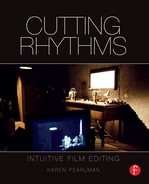My interest in writing this book began when I was finishing the practical course work for my M.A. in Editing at the Australian Film Television and Radio School (AFTRS). I was approached by the head of the editing department, Bill Russo, ASE, about the possibility of researching editing history and theory for the purposes of teaching incoming students. From that discussion, the idea was to base my research on words that are frequently used, but infrequently defined in the regular course of editing a film,1 such as “structure,” “montage,” and “rhythm.” Bill’s expertise in editing came about through many years of practical experience. The AFTRS, in trying to train an editor in a few short years, was already very focused on providing a variety of practical editing experiences. Bill responded enthusiastically to my ideas for research because he wanted to know: What could film school offer that was different from working in the field? And, more importantly: Could principles be articulated and communicated that might otherwise be understood only through years of practice or experience?
In the course of my research I found that it was a relatively straight-forward matter to draw together and teach many specific principles about Soviet montage theory, techniques of continuity cutting, structure, devices, and common scenes by studying films and books and talking to writers, directors, and editors. However, rhythm, as a topic, was elusive. A literature search yielded contradictory, limited, or inconclusive definitions. Experienced editors, although in agreement that rhythm (along with structure) is what an editor shapes in a filmmaking process, were reluctant to try to articulate a definition. Finally, David Bordwell and Kristen Thompson’s Film Art threw down the gauntlet with the comment “the issue of rhythm in cinema is enormously complex and still not well understood.”2 Perhaps perversely drawn to the most ineffable, or at least the trickiest, topic of study I had yet found, I set out on my quest to understand rhythm in film editing.
Since discussion of rhythm in film editing is rare I have had the opportunity to draw on a range of disciplines, including film studies, dance, and neurology, to help me formulate some principles. In the first four chapters of this book I develop ideas about intuition, editing as a choreographic process, and the tools and purposes of rhythm. Then I look at the different kinds of rhythms with which editors work. In the new edition I have added chapters about collaboration and editing thinking. Cutting Rhythms is a book about editing theory and practice. It looks at the creative processes, tools, and functions of rhythm in film editing. Cutting Rhythms looks at something central to the art of filmmaking: rhythm, a word often used and rarely defined, and it aims to enhance rhythmic creativity and intuition.
